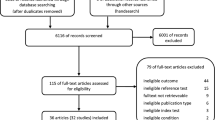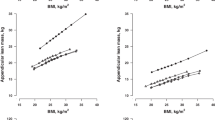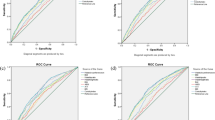Abstract
Overweight and obesity have become a major public health problem in both developing and developed countries as they are causally related to a wide spectrum of chronic diseases including type II diabetes, cardiovascular diseases and cancer. However, uncertainty regarding the most appropriate means by which to define excess body weight remains. Traditionally, body mass index (BMI) has been the most widely used method by which to determine the prevalence of overweight in, and across, populations as well as an individual's level of risk. However, in recent years, measures of central obesity, principally waist circumference and the waist:hip ratio and to a lesser extent the waist:height ratio, which more accurately describe the distribution of body fat compared with BMI, have been suggested to be more closely associated with subsequent morbidity and mortality. There is also uncertainty about how these measures perform across diverse ethnic groups; earlier, most of the evidence regarding the relationships between excess weight and risk has been derived chiefly from Caucasian populations, and hence, it remains unclear whether the relationships are consistent in non-Caucasian populations. The purpose of this review, therefore, is to provide an overview of the current evidence-base focusing predominantly on three main questions: (1) Which, if any, of the commonly used anthropometric measures to define excess weight is more strongly associated with cardiovascular risk? (2) Which of the anthropometric measures is a better discriminator of risk? and (3) Are there any notable differences in the strength and nature of these associations across diverse ethnic groups?
This is a preview of subscription content, access via your institution
Access options
Subscribe to this journal
Receive 12 print issues and online access
$259.00 per year
only $21.58 per issue
Buy this article
- Purchase on SpringerLink
- Instant access to full article PDF
Prices may be subject to local taxes which are calculated during checkout

Similar content being viewed by others
References
Ashwell M, Hsieh SD (2005). Six reasons why the waist-to-height ratio is a rapid and effective global indicator for health risks of obesity and how its use could simplify the international public health message on obesity. Int J Food Sci Nutr 56, 303–307.
Asia Pacific Cohort Studies Collaboration (2006). Central obesity and risk of cardiovascular disease in the Asia Pacific region. Asia Pac J Clin Nutr 15, 287–292.
Barzi F, Woodward M, Czernichow S, Lee CMY, Kang JH, Janus E et al. (in press). The discrimination of dyslipidaemia using anthropometric measures in ethnically diverse populations of the Asia–Pacific region: the Obesity in Asia Collaboration. Obes Rev.
Bell C, Adair LS, Popkin B (2002). Ethnic differences in the association between body mass index and hypertension. Am J Epidemiol 155, 346–353.
Bigaard J, Frederiksen K, Tjønneland A, Thomsen BL, Overvad K, Heitmann BL et al. (2005). Waist circumference and body composition in relation to all-cause mortality in middle-aged men and women. Int J Obes (Lond) 29, 778–784.
Chouraki V, Wagner A, Ferrières J, Kee F, Bingham A, Haas B et al. (2008). Smoking habits, waist circumference and coronary artery disease risk relationship: the PRIME study. Eur J Cardiovasc Prev Rehabil 15, 625–630.
Connolly BS, Barnett C, Vogt K, Li T, Stone J, Boyd N (2002). A meta-analysis of published literature on waist-to-hip ratio and risk of breast cancer. Nutr Cancer 44, 127–138.
de Koning L, Merchant AT, Pogue J, Anand SS (2007). Waist circumference and waist-to-hip ratio as predictors of cardiovascular events: meta-regression analysis of prospective studies. Eur Heart J 28, 850–856.
Decoda Study Group. Nyamdorj R, Qiao Q, Lam TH, Tuomilehto J, Ho SY, Pitkäniemi J et al. (2008). BMI compared with central obesity indicators in relation to diabetes and hypertension in Asians. Obesity (Silver Spring) 16, 1622–1635.
Deurenberg P, Deurenberg-Yap M (2003). Validity of body composition methods across ethnic population groups. In: Modern aspects of nutrition: present knowledge and future perspectives. Forum Nutr Basel Karger 56, 299–301.
Gelber RP, Gaziano JM, Orav EJ, Manson JE, Buring JE, Kurth T (2008). Measures of obesity and cardiovascular risk among men and women. J Am Coll Cardiol 52, 605–615.
Ho SY, Lam TH, Janus ED (2003). The Hong Kong Cardiovascular Risk Factor Prevalence Study steering committee. Waist to stature ratio is more strongly associated with cardiovascular risk factors than other simple anthropometric indices. Ann Epidemiol 13, 683–691.
Huxley R, James WP, Barzi F, Patel JV, Lear SA, Suriyawongpaisal P et al. (2008). Obesity in Asia Collaboration. Ethnic comparisons of the cross-sectional relationships between measures of body size with diabetes and hypertension. Obes Rev 9 (Suppl 1), 53–61.
Jansses I, Katzmarzyk PT, Ross P (2004). Waist circumference and not body mass index explains obesity-related health risk. Am J Clin Nutr 79, 379–384.
Lee CM, Huxley RR, Wildman RP, Woodward M (2008). Indices of abdominal obesity are better discriminators of cardiovascular risk factors than BMI: a meta-analysis. J Clin Epidemiol 61, 646–653.
Prospective Studies Collaboration (2009). Body-mass index and cause-specific mortality in 900 000 adults: collaborative analyses of 57 prospective studies. Lancet 363, 1083–1096.
Vazquez G, Duval S, Jacobs Jr DR, Silventoinen K (2007). Comparison of body mass index, waist circumference, and waist/hip ratio in predicting incident diabetes: a meta-analysis. Epidemiol Rev 29, 115–128.
Wei M, Gaskill SP, Haffner SM, Stern MP (1997). Waist circumference as the best predictor of noninsulin dependent diabetes mellitus (NIDDM) compared to body mass index, waist/hip ratio and other anthropometric measurements in Mexican Americans--a 7-year prospective study. Obes Res 5, 16–23.
Welborn TA, Dhaliwal SS (2007). Preferred clinical measures of central obesity for predicting mortality. Eur J Clin Nutr 61, 1373–1379.
Whincup PH, Gilg JA, Papacosta O, Seymour C, Miller GJ, Alberti KG et al. (2002). Early evidence of ethnic differences in cardiovascular risk: cross sectional comparison of British South Asian and white children. BMJ 324, 635.
World Health Organization (2000a). Obesity: Preventing and Managing the Global Epidemic. WHO Technical report series No. 894. WHO: Geneva.
World Health Organization. International Association for the Study of Obesity, International Obesity Task Force (2000b). Health Communications Sydney Australia. The Asia Pacific Perspective: Redefining obesity and its treatment.
Yusuf S, Hawken S, Ounpuu S, Bautista L, Franzosi MG, Commerford P et al. (2005). Obesity and the risk of myocardial infarction in 27 000 participants from 52 countries: a case-control study. Lancet 366, 1640–1649.
Acknowledgements
Rachel Huxley is funded by a Career Development Award from the National Heart Foundation of Australia.
Author information
Authors and Affiliations
Corresponding author
Rights and permissions
About this article
Cite this article
Huxley, R., Mendis, S., Zheleznyakov, E. et al. Body mass index, waist circumference and waist:hip ratio as predictors of cardiovascular risk—a review of the literature. Eur J Clin Nutr 64, 16–22 (2010). https://doi.org/10.1038/ejcn.2009.68
Received:
Accepted:
Published:
Issue Date:
DOI: https://doi.org/10.1038/ejcn.2009.68
Keywords
This article is cited by
-
Characteristics and correlation of body fat distribution and brachial-ankle pulse wave velocity in adults aged 20–59 years: a cross-sectional study
BMC Cardiovascular Disorders (2024)
-
Mobile health behaviour change support system as independent treatment tool for obesity: a randomized controlled trial
International Journal of Obesity (2024)
-
Association between long-term weight loss and obesity-related complications defined by Edmonton obesity staging system: analysis from the NHANES (2011–2018)
European Journal of Clinical Nutrition (2024)
-
Early-life residential green spaces and traffic exposure in association with young adult body composition: a longitudinal birth cohort study of twins
Environmental Health (2023)
-
Prevalence and characteristics of metabolic syndrome and its components among adults living with and without HIV in Nigeria: a single-center study
BMC Endocrine Disorders (2023)



